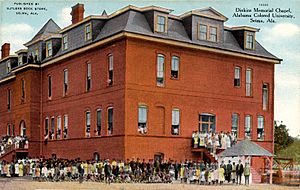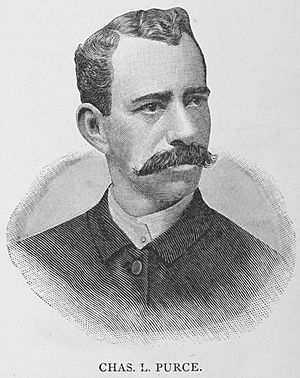Selma University facts for kids
 |
|
|
Former names
|
Alabama Baptist Normal and Theological School (1878–1908) |
|---|---|
| Type | Private, HBCU, Bible college |
| Established | 1878 |
| Accreditation | ABHE |
|
Religious affiliation
|
Alabama State Missionary Baptist Convention |
| President | Stanford E. Angion |
| Students | 50 |
| Undergraduates | 31 |
| Postgraduates | 19 |
| Location |
,
,
United States
32°25′12″N 87°01′55″W / 32.41997°N 87.03205°W |
| Colors | Blue and White |
| Website | https://www.selmau.edu/ |
|
Selma University Historic District
|
|
| NRHP reference No. | 100009126 |
| Significant dates | |
| Added to NRHP | July 14, 2023 |
Selma University is a private college in Selma, Alabama, USA. It is a historically black college, meaning it was founded to educate African American students. It is also a Bible college, focusing on religious studies. The university is connected to the Alabama State Missionary Baptist Convention.
Contents
History of Selma University
Founding and Early Years
Selma University started in 1878. It was first called the Alabama Baptist Normal and Theological School. Its main goal was to train African Americans to become ministers and teachers.
Later that year, the school bought the old Selma Fair Grounds. They moved into the fair's former buildings. Important ministers like William H. McAlpine and James A. Foster helped start the school.
In 1874, the first leaders were chosen in Mobile, Alabama. These included C. O. Booth and William H. McAlpine. In 1877, it was decided that Selma would be the school's home. The school officially opened four years later. It was located in the Saint Phillips Street Baptist Church in Selma. This church later became the First Baptist Church.

In 1881, the state officially recognized the school. It was named the Alabama Baptist Normal and Theological School of Selma. In 1886, Charles L. Purce became the president. He took over from Edward M. Brawley. Purce was a successful leader. He helped the university pay off a large debt. In 1894, he left to lead Simmons College of Kentucky.
Name Change and Focus Shift
On May 14, 1908, the school's name officially changed to Selma University.
In the late 1980s, Selma University grew. It changed from a two-year program to a four-year one. However, in 2000, the university began to focus more on religious studies. It started becoming a Bible college.
In 2005, the school moved closer to getting full accreditation. This means it met certain standards for education. By February 2009, Selma University received its first accreditation. This was from the Association for Biblical Higher Education.
Recent Challenges and Leadership
After getting full accreditation in 2014, Selma University faced some challenges. In 2019, it lost some important government funding. This was because the university had financial difficulties. It also had trouble keeping good student records.
The university worked to improve its financial situation. It also worked to better manage student information.
In February 2020, the school was put on probation. This was by its accrediting body, the ABHE. This meant the school needed to make improvements.
Alvin A. Cleveland was president for over twenty years. In June 2020, Eddie Hill became the new president. He was brought in to help with the university's financial issues. He was the first president who was not also a minister.
Eddie Hill resigned in February 2021 after eight months. Dr. Stanford Angion was then chosen as the interim president.
A notable former student is William Hicks (pastor).
Campus Buildings and Improvements
Selma University has many important buildings. Each one has a story.
- Stone Hall: This was a dormitory for girls. It was built in 1889 by the Women's Baptist State Convention. It was named after Miss Susie Stone.
- Dinkins Memorial Chapel: This chapel was finished in 1904. It honors Reverend C. S. Dinkins, a former president. It was rebuilt in 1921 after a fire. It was updated again in 1980.
- Foster Hall: Built in 1910, this building is named after Susie C. Foster. She was president of the Women's Convention.
- Cleveland Hall: This hall was built in 1948. It was named for M. C. Cleveland Sr. Materials from old Selma buildings were used to construct it.
- Gibbs Dining Hall: Built in 1953, this hall is named after Henrietta M. Gibbs.
- Stone-Robinson Library: This library was built in 1960. It honors Susie Stone and Reverend U. J. Robinson.
- Jemison-Owens Auditorium/Gymnasium: Completed in 1966, this building is for events and sports. It is named after Reverend D. V. Jemison and James H. Owens.
- Hood-Ware Dormitory: This dormitory for men was finished in 1970.
- Jackson-Wilson Dormitory: This dormitory for women was also completed in 1970.
- A. W. Wilson Science and Computer Hall: This building was finished in 1979. It is used for science and computer studies.
In 1988, the science area expanded. An annex was added with an auditorium and labs. More improvements followed. These included a writing lab, a math lab, and an expanded library. The library now has a center for audiovisual learning.
Parts of the campus were recognized as historic places in 2023. They were added to the National Register of Historic Places.
See also

